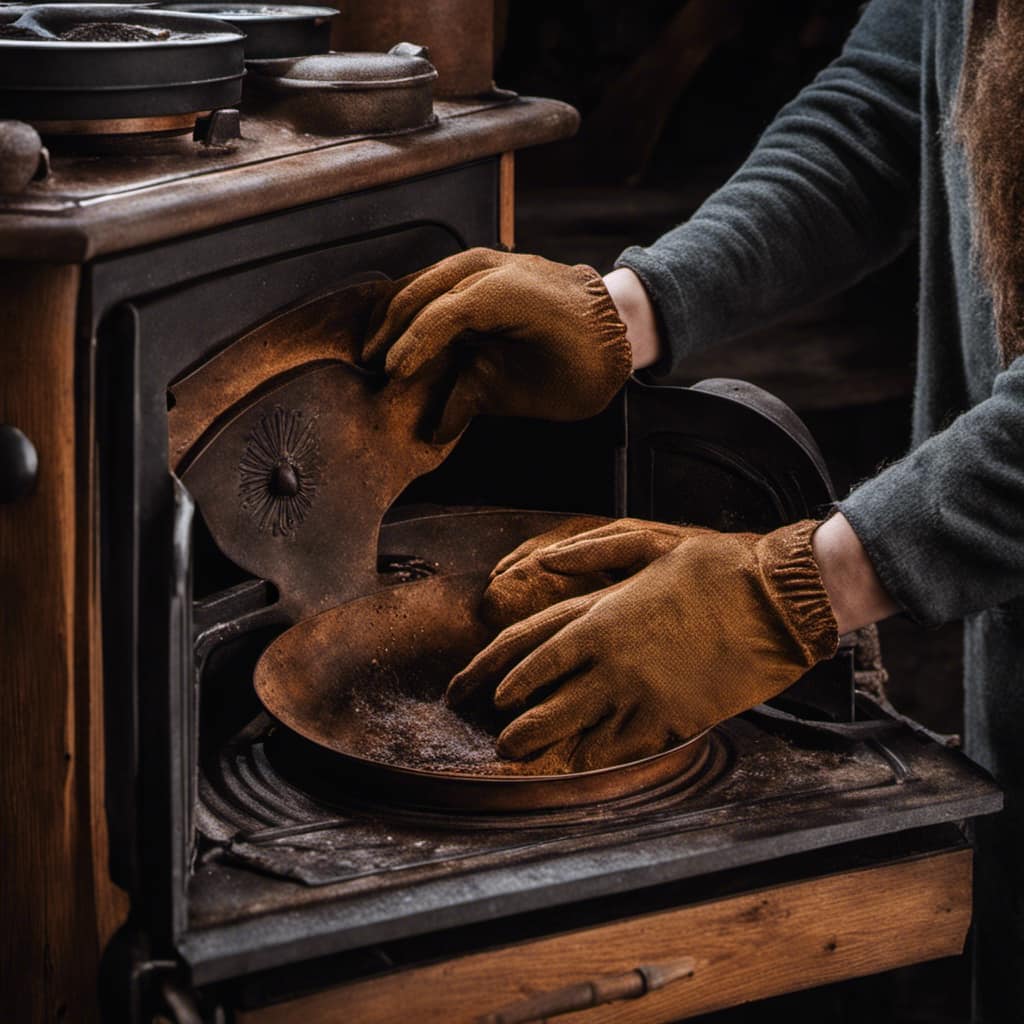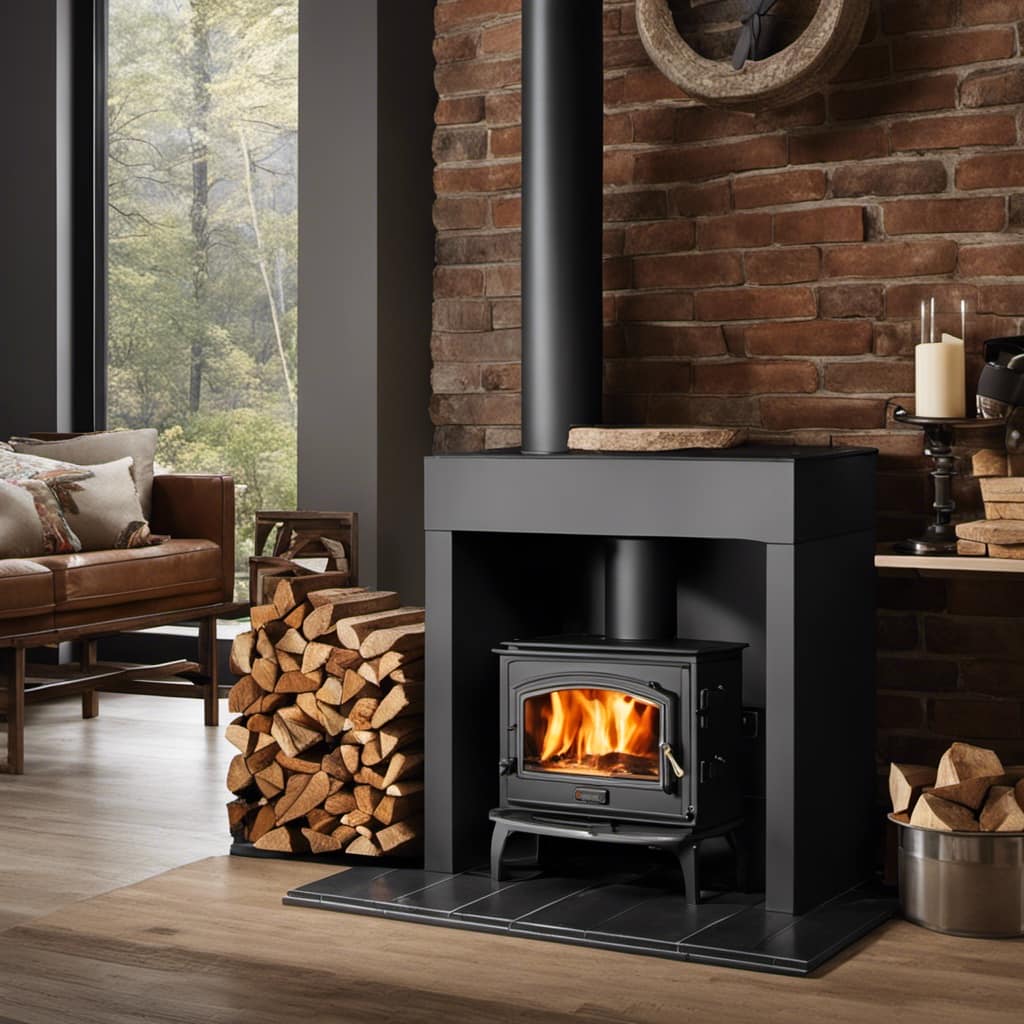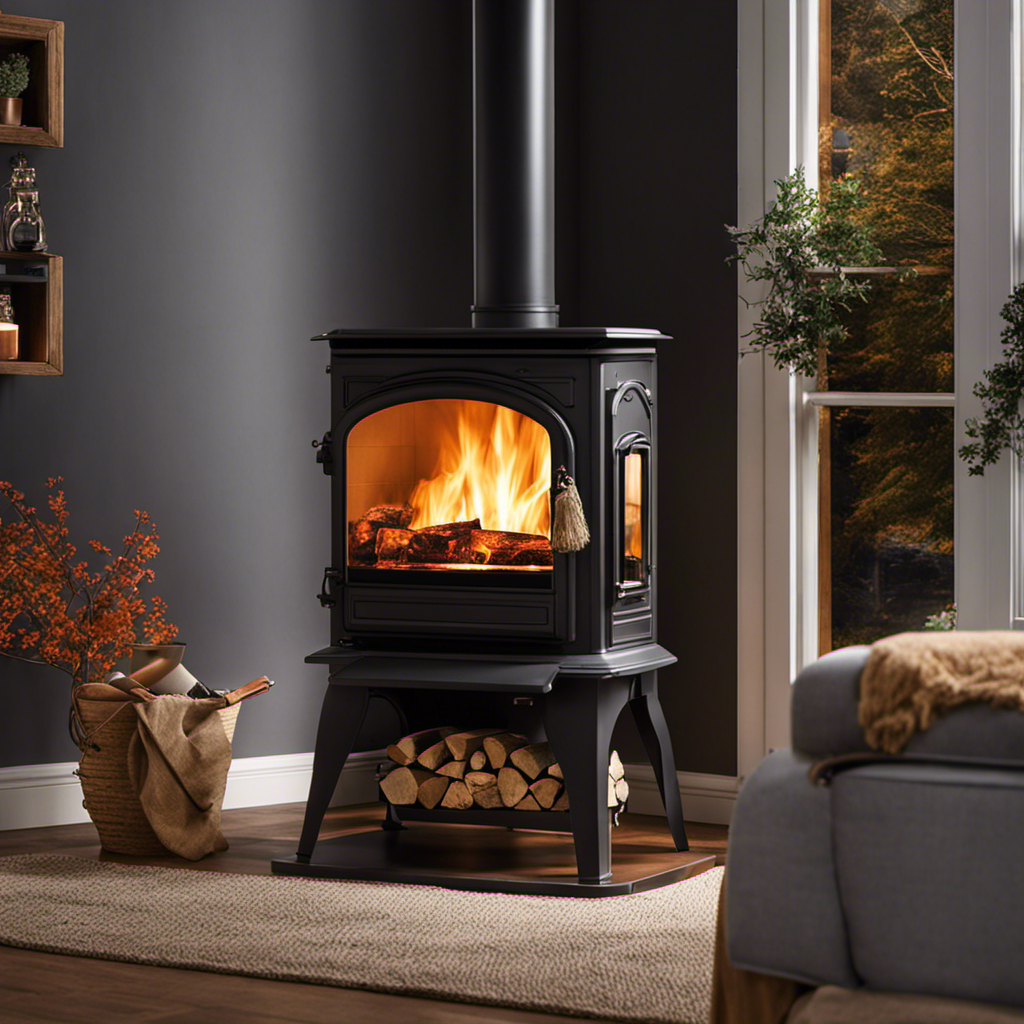Greetings! It appears you possess a wood stove and are considering adding tiles around it, is that right? You’ve come to the right place.
In this article, I’m going to walk you through the step-by-step process of how to tile around your wood stove like a pro.
From choosing the perfect tiles to grouting and finishing, I’ve got you covered.
So grab your tools and let’s get started on transforming your wood stove area into a stylish and functional masterpiece.

Key Takeaways
- Consider neutral colors like beige, gray, or brown for a timeless and versatile look.
- Use larger tiles for a seamless and modern appearance, or smaller tiles for visual interest and texture.
- Clean and prepare the surface before tiling by removing loose material, filling in cracks, and leveling the surface.
- Use high-quality adhesive and grout suitable for high-temperature environments when installing tiles around the wood stove.
Choosing the Right Tiles for Your Wood Stove Area
I need to choose the perfect tiles for my wood stove area. When it comes to tile color options, I want to select something that complements the overall aesthetic of the room while also being practical for the high-heat environment around the wood stove.
Neutral colors like beige, gray, or brown can provide a timeless and versatile look. Additionally, darker shades can help to hide any potential soot or ash that may accumulate over time.
As for tile size considerations, larger tiles can create a more seamless and modern appearance, while smaller tiles can add visual interest and texture.
Ultimately, I’ll carefully consider both the color and size of the tiles to ensure a cohesive and functional design for my wood stove area.

Preparing the Surface for Tiling
Before tiling, it’s important to thoroughly clean and level the surface to ensure a smooth and durable finish. This step is crucial in achieving a professional-looking tile installation. To help you understand the importance of surface preparation, here is a table outlining the key steps involved:
| Step | Description | Tools Required |
|---|---|---|
| 1 | Clean the surface | Scrub brush, cleaner |
| 2 | Remove any loose material | Putty knife, vacuum |
| 3 | Fill in any cracks | Patching compound |
| 4 | Sand the surface | Sandpaper |
| 5 | Level the surface | Level, floor patch |
Once the surface is clean and level, you can proceed with applying tile adhesive and using tile spacers to ensure proper spacing between tiles. The adhesive will securely bond the tiles to the surface, while the spacers will maintain consistent spacing for a professional finish. Remember to follow the manufacturer’s instructions for the adhesive and spacers to achieve the best results.
Installing the First Row of Tiles Around the Wood Stove
Carefully aligning the first row of tiles around the wood stove, I ensure that each tile is securely adhered to the surface. Properly sealing tiles around wood stoves is essential to prevent any heat or moisture from damaging the surrounding area. To create a seamless tile transition, there are a few tips to keep in mind.
Firstly, it’s crucial to use a high-quality adhesive that’s specifically designed for heat resistance. This will ensure the tiles stay in place even under high temperatures. Additionally, using grout that’s suitable for high-temperature environments will help to prevent cracking or discoloration. It’s also important to leave a small gap between the tiles and the stove to allow for expansion and contraction.

Transitioning smoothly into the next section, cutting and fitting tiles around obstacles requires precision and attention to detail.
Cutting and Fitting Tiles Around Obstacles
To achieve a seamless tile installation, I use a tile saw to precisely cut and fit the tiles around obstacles such as pipes and corners. Cutting techniques play a crucial role in ensuring a perfect fit and a professional finish.
When working with tiles, it’s important to have the right tools and knowledge to make accurate cuts. A tile saw allows me to make precise cuts, ensuring that the tiles fit perfectly around any obstructions.
Additionally, alternative materials such as tile nippers or angle grinders can also be used for more intricate cuts. These tools allow for greater flexibility and can be useful when dealing with irregular shapes or curves.

Can Tiling Around a Wood Stove Help Improve Heating on the Second Floor?
Yes, tiling around a wood stove can help distribute more wood stove heat second floor. The tiles act as a heat conductor, providing more efficient heating for the upper level of the house. This can help improve the overall warmth and comfort of the second floor during the colder months.
Grouting and Finishing the Wood Stove Tile Installation
I skillfully grouted and finished the wood stove tile installation, creating a stunning and polished final look. The grout color options I considered were carefully chosen to complement the overall design of the room.
I decided on a warm, earthy tone that not only added depth to the tiles but also blended seamlessly with the wood stove.
To ensure the longevity and durability of the tile surface, I made sure to properly seal it. By applying a high-quality sealant, I created a protective barrier that prevents moisture and stains from penetrating the tiles. This not only enhances the longevity of the installation but also makes it easier to clean and maintain.
The combination of the carefully selected grout color and the sealed tile surface truly elevates the overall aesthetic of the wood stove area.

Frequently Asked Questions
How Do I Ensure That the Tiles I Choose for My Wood Stove Area Are Heat-Resistant?
To ensure that the tiles I choose for my wood stove area are heat-resistant, I need to carefully consider their rating and material. Properly installing the tiles around the stove is also crucial for their longevity and safety.
Can I Tile Directly Over a Wooden Surface Around My Wood Stove, or Do I Need to Use a Backer Board?
Sure, you can use cement board instead of a backer board for tiling around a wood stove. It provides a sturdy surface and helps prevent moisture damage. To seal the edges of the tiles, use a high-quality silicone caulk for maximum protection.
Is It Necessary to Remove the Existing Flooring Around the Wood Stove Before Tiling?
Removing the existing flooring around the wood stove before tiling is not necessary. However, it is important to insulate the wood stove properly to protect the surrounding area and ensure safety.
What Tools Do I Need to Cut and Shape the Tiles to Fit Around the Wood Stove and Other Obstacles?
To cut and shape tiles to fit around the wood stove and other obstacles, you’ll need a few essential tools. These include a tile cutter, tile nippers, a wet saw, and possibly a grinder for more intricate cuts.

How Long Does It Typically Take for the Grout to Fully Cure Before I Can Use My Wood Stove Again?
It typically takes about 24-48 hours for the grout to fully cure before I can use my wood stove again. It’s important to choose a grout that is heat resistant to ensure safety and longevity.
Conclusion
In conclusion, tiling around a wood stove can be a challenging but rewarding project. By choosing the right tiles, preparing the surface properly, and carefully installing and cutting the tiles, you can create a beautiful and functional tile surround for your wood stove.
Did you know that according to a survey, homeowners who install tile around their wood stoves often see an increase in the value of their homes by up to 10%? So why not give it a try and enhance the aesthetic appeal of your wood stove area?
Growing up surrounded by the vast beauty of nature, Sierra was always drawn to the call of the wild. While others sought the comfort of the familiar, she ventured out, embracing the unpredictable and finding stories in the heartbeat of nature.
At the epicenter of every remarkable venture lies a dynamic team—a fusion of diverse talents, visions, and passions. The essence of Best Small Wood Stoves is crafted and refined by such a trio: Sierra, Logan, and Terra. Their collective expertise has transformed the platform into a leading authority on small wood stoves, radiating warmth and knowledge in equal measure.











